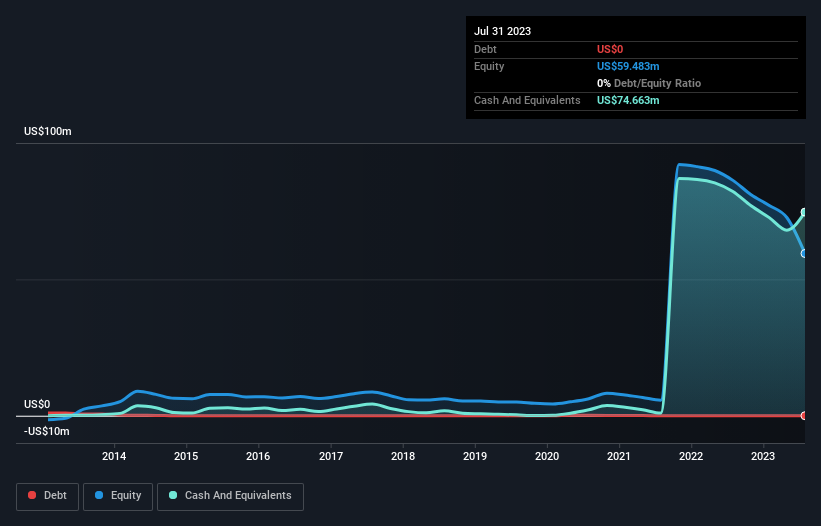Companies Like PharmaCyte Biotech (NASDAQ:PMCB) Are In A Position To Invest In Growth
There's no doubt that money can be made by owning shares of unprofitable businesses. For example, although software-as-a-service business Salesforce.com lost money for years while it grew recurring revenue, if you held shares since 2005, you'd have done very well indeed. But while the successes are well known, investors should not ignore the very many unprofitable companies that simply burn through all their cash and collapse.
Given this risk, we thought we'd take a look at whether PharmaCyte Biotech (NASDAQ:PMCB) shareholders should be worried about its cash burn. In this article, we define cash burn as its annual (negative) free cash flow, which is the amount of money a company spends each year to fund its growth. First, we'll determine its cash runway by comparing its cash burn with its cash reserves.
Check out our latest analysis for PharmaCyte Biotech
How Long Is PharmaCyte Biotech's Cash Runway?
You can calculate a company's cash runway by dividing the amount of cash it has by the rate at which it is spending that cash. As at July 2023, PharmaCyte Biotech had cash of US$75m and no debt. Looking at the last year, the company burnt through US$2.4m. So it had a very long cash runway of many years from July 2023. Even though this is but one measure of the company's cash burn, the thought of such a long cash runway warms our bellies in a comforting way. Depicted below, you can see how its cash holdings have changed over time.
How Is PharmaCyte Biotech's Cash Burn Changing Over Time?
PharmaCyte Biotech didn't record any revenue over the last year, indicating that it's an early stage company still developing its business. Nonetheless, we can still examine its cash burn trajectory as part of our assessment of its cash burn situation. While it hardly paints a picture of imminent growth, the fact that it has reduced its cash burn by 40% over the last year suggests some degree of prudence. Admittedly, we're a bit cautious of PharmaCyte Biotech due to its lack of significant operating revenues. So we'd generally prefer stocks from this list of stocks that have analysts forecasting growth.
How Easily Can PharmaCyte Biotech Raise Cash?
Even though it has reduced its cash burn recently, shareholders should still consider how easy it would be for PharmaCyte Biotech to raise more cash in the future. Issuing new shares, or taking on debt, are the most common ways for a listed company to raise more money for its business. One of the main advantages held by publicly listed companies is that they can sell shares to investors to raise cash and fund growth. By comparing a company's annual cash burn to its total market capitalisation, we can estimate roughly how many shares it would have to issue in order to run the company for another year (at the same burn rate).
PharmaCyte Biotech has a market capitalisation of US$20m and burnt through US$2.4m last year, which is 12% of the company's market value. Given that situation, it's fair to say the company wouldn't have much trouble raising more cash for growth, but shareholders would be somewhat diluted.
Is PharmaCyte Biotech's Cash Burn A Worry?
As you can probably tell by now, we're not too worried about PharmaCyte Biotech's cash burn. For example, we think its cash runway suggests that the company is on a good path. And even though its cash burn relative to its market cap wasn't quite as impressive, it was still a positive. Looking at all the measures in this article, together, we're not worried about its rate of cash burn; the company seems well on top of its medium-term spending needs. On another note, PharmaCyte Biotech has 3 warning signs (and 2 which are significant) we think you should know about.
Of course PharmaCyte Biotech may not be the best stock to buy. So you may wish to see this free collection of companies boasting high return on equity, or this list of stocks that insiders are buying.
Have feedback on this article? Concerned about the content? Get in touch with us directly. Alternatively, email editorial-team (at) simplywallst.com.
This article by Simply Wall St is general in nature. We provide commentary based on historical data and analyst forecasts only using an unbiased methodology and our articles are not intended to be financial advice. It does not constitute a recommendation to buy or sell any stock, and does not take account of your objectives, or your financial situation. We aim to bring you long-term focused analysis driven by fundamental data. Note that our analysis may not factor in the latest price-sensitive company announcements or qualitative material. Simply Wall St has no position in any stocks mentioned.

